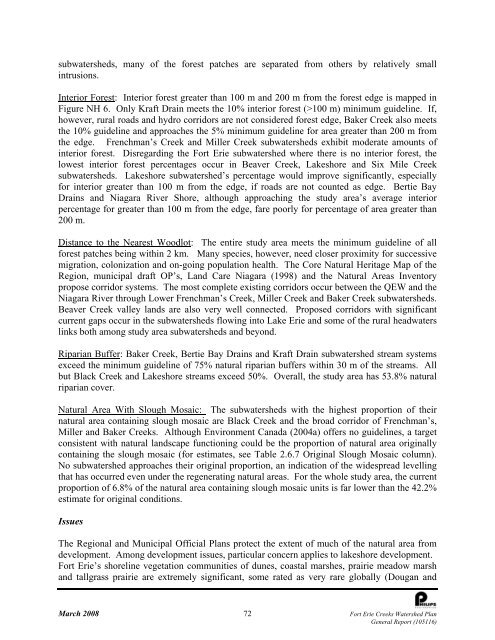Fort Erie Creeks Watershed Plan - Niagara Peninsula Conservation ...
Fort Erie Creeks Watershed Plan - Niagara Peninsula Conservation ...
Fort Erie Creeks Watershed Plan - Niagara Peninsula Conservation ...
Create successful ePaper yourself
Turn your PDF publications into a flip-book with our unique Google optimized e-Paper software.
subwatersheds, many of the forest patches are separated from others by relatively small<br />
intrusions.<br />
Interior Forest: Interior forest greater than 100 m and 200 m from the forest edge is mapped in<br />
Figure NH 6. Only Kraft Drain meets the 10% interior forest (>100 m) minimum guideline. If,<br />
however, rural roads and hydro corridors are not considered forest edge, Baker Creek also meets<br />
the 10% guideline and approaches the 5% minimum guideline for area greater than 200 m from<br />
the edge. Frenchman’s Creek and Miller Creek subwatersheds exhibit moderate amounts of<br />
interior forest. Disregarding the <strong>Fort</strong> <strong>Erie</strong> subwatershed where there is no interior forest, the<br />
lowest interior forest percentages occur in Beaver Creek, Lakeshore and Six Mile Creek<br />
subwatersheds. Lakeshore subwatershed’s percentage would improve significantly, especially<br />
for interior greater than 100 m from the edge, if roads are not counted as edge. Bertie Bay<br />
Drains and <strong>Niagara</strong> River Shore, although approaching the study area’s average interior<br />
percentage for greater than 100 m from the edge, fare poorly for percentage of area greater than<br />
200 m.<br />
Distance to the Nearest Woodlot: The entire study area meets the minimum guideline of all<br />
forest patches being within 2 km. Many species, however, need closer proximity for successive<br />
migration, colonization and on-going population health. The Core Natural Heritage Map of the<br />
Region, municipal draft OP’s, Land Care <strong>Niagara</strong> (1998) and the Natural Areas Inventory<br />
propose corridor systems. The most complete existing corridors occur between the QEW and the<br />
<strong>Niagara</strong> River through Lower Frenchman’s Creek, Miller Creek and Baker Creek subwatersheds.<br />
Beaver Creek valley lands are also very well connected. Proposed corridors with significant<br />
current gaps occur in the subwatersheds flowing into Lake <strong>Erie</strong> and some of the rural headwaters<br />
links both among study area subwatersheds and beyond.<br />
Riparian Buffer: Baker Creek, Bertie Bay Drains and Kraft Drain subwatershed stream systems<br />
exceed the minimum guideline of 75% natural riparian buffers within 30 m of the streams. All<br />
but Black Creek and Lakeshore streams exceed 50%. Overall, the study area has 53.8% natural<br />
riparian cover.<br />
Natural Area With Slough Mosaic: The subwatersheds with the highest proportion of their<br />
natural area containing slough mosaic are Black Creek and the broad corridor of Frenchman’s,<br />
Miller and Baker <strong>Creeks</strong>. Although Environment Canada (2004a) offers no guidelines, a target<br />
consistent with natural landscape functioning could be the proportion of natural area originally<br />
containing the slough mosaic (for estimates, see Table 2.6.7 Original Slough Mosaic column).<br />
No subwatershed approaches their original proportion, an indication of the widespread levelling<br />
that has occurred even under the regenerating natural areas. For the whole study area, the current<br />
proportion of 6.8% of the natural area containing slough mosaic units is far lower than the 42.2%<br />
estimate for original conditions.<br />
Issues<br />
The Regional and Municipal Official <strong>Plan</strong>s protect the extent of much of the natural area from<br />
development. Among development issues, particular concern applies to lakeshore development.<br />
<strong>Fort</strong> <strong>Erie</strong>’s shoreline vegetation communities of dunes, coastal marshes, prairie meadow marsh<br />
and tallgrass prairie are extremely significant, some rated as very rare globally (Dougan and<br />
March 2008 72 <strong>Fort</strong> <strong>Erie</strong> <strong>Creeks</strong> <strong>Watershed</strong> <strong>Plan</strong><br />
General Report (105116)
















